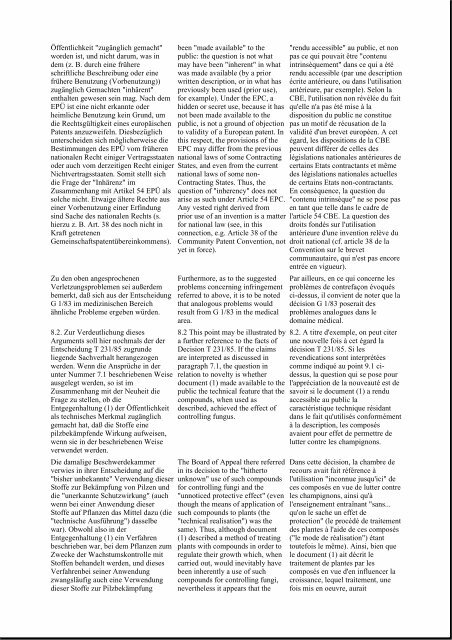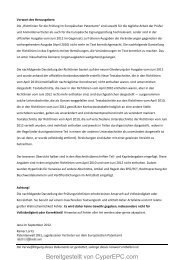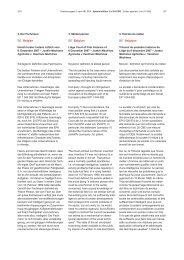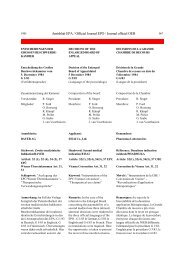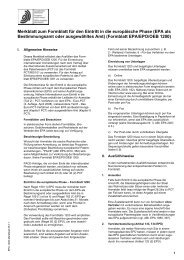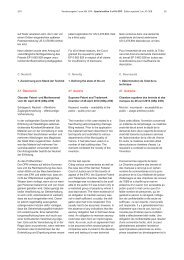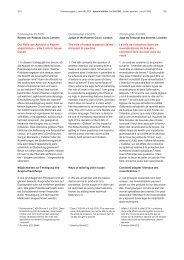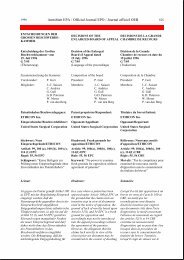Amtsblatt EPA / Official Journal EPO / Journal officiel OEB - CyberEPC
Amtsblatt EPA / Official Journal EPO / Journal officiel OEB - CyberEPC
Amtsblatt EPA / Official Journal EPO / Journal officiel OEB - CyberEPC
You also want an ePaper? Increase the reach of your titles
YUMPU automatically turns print PDFs into web optimized ePapers that Google loves.
Öffentlichkeit "zugänglich gemacht"worden ist, und nicht darum, was indem (z. B. durch eine frühereschriftliche Beschreibung oder einefrühere Benutzung (Vorbenutzung))zugänglich Gemachten "inhärent"enthalten gewesen sein mag. Nach demEPÜ ist eine nicht erkannte oderheimliche Benutzung kein Grund, umdie Rechtsgültigkeit eines europäischenPatents anzuzweifeln. Diesbezüglichunterscheiden sich möglicherweise dieBestimmungen des EPÜ vom früherennationalen Recht einiger Vertragsstaatenoder auch vom derzeitigen Recht einigerNichtvertragsstaaten. Somit stellt sichdie Frage der "Inhärenz" imZusammenhang mit Artikel 54 EPÜ alssolche nicht. Etwaige ältere Rechte auseiner Vorbenutzung einer Erfindungsind Sache des nationalen Rechts (s.hierzu z. B. Art. 38 des noch nicht inKraft getretenenGemeinschaftspatentübereinkommens).Zu den oben angesprochenenVerletzungsproblemen sei außerdembemerkt, daß sich aus der EntscheidungG 1/83 im medizinischen Bereichähnliche Probleme ergeben würden.8.2. Zur Verdeutlichung diesesArguments soll hier nochmals der derEntscheidung T 231/85 zugrundeliegende Sachverhalt herangezogenwerden. Wenn die Ansprüche in derunter Nummer 7.1 beschriebenen Weiseausgelegt werden, so ist imZusammenhang mit der Neuheit dieFrage zu stellen, ob dieEntgegenhaltung (1) der Öffentlichkeitals technisches Merkmal zugänglichgemacht hat, daß die Stoffe einepilzbekämpfende Wirkung aufweisen,wenn sie in der beschriebenen Weiseverwendet werden.Die damalige Beschwerdekammerverwies in ihrer Entscheidung auf die"bisher unbekannte" Verwendung dieserStoffe zur Bekämpfung von Pilzen unddie "unerkannte Schutzwirkung" (auchwenn bei einer Anwendung dieserStoffe auf Pflanzen das Mittel dazu (die"technische Ausführung") dasselbewar). Obwohl also in derEntgegenhaltung (1) ein Verfahrenbeschrieben war, bei dem Pflanzen zumZwecke der Wachstumskontrolle mitStoffen behandelt werden, und diesesVerfahrenbei seiner Anwendungzwangsläufig auch eine Verwendungdieser Stoffe zur Pilzbekämpfungbeen "made available" to thepublic: the question is not whatmay have been "inherent" in whatwas made available (by a priorwritten description, or in what haspreviously been used (prior use),for example). Under the EPC, ahidden or secret use, because it hasnot been made available to thepublic, is not a ground of objectionto validity of a European patent. Inthis respect, the provisions of theEPC may differ from the previousnational laws of some ContractingStates, and even from the currentnational laws of some non-Contracting States. Thus, thequestion of "inherency" does notarise as such under Article 54 EPC.Any vested right derived fromprior use of an invention is a matterfor national law (see, in thisconnection, e.g. Article 38 of theCommunity Patent Convention, notyet in force).Furthermore, as to the suggestedproblems concerning infringementreferred to above, it is to be notedthat analogous problems wouldresult from G 1/83 in the medicalarea.8.2 This point may be illustrated bya further reference to the facts ofDecision T 231/85. If the claimsare interpreted as discussed inparagraph 7.1, the question inrelation to novelty is whetherdocument (1) made available to thepublic the technical feature that thecompounds, when used asdescribed, achieved the effect ofcontrolling fungus.The Board of Appeal there referredin its decision to the "hithertounknown" use of such compoundsfor controlling fungi and the"unnoticed protective effect" (eventhough the means of application ofsuch compounds to plants (the"technical realisation") was thesame). Thus, although document(1) described a method of treatingplants with compounds in order toregulate their growth which, whencarried out, would inevitably havebeen inherently a use of suchcompounds for controlling fungi,nevertheless it appears that the"rendu accessible" au public, et nonpas ce qui pouvait être "contenuintrinsèquement" dans ce qui a étérendu accessible (par une descriptionécrite antérieure, ou dans l'utilisationantérieure, par exemple). Selon laCBE, l'utilisation non révélée du faitqu'elle n'a pas été mise à ladisposition du public ne constituepas un motif de récusation de lavalidité d'un brevet européen. A cetégard, les dispositions de la CBEpeuvent différer de celles deslégislations nationales antérieures decertains Etats contractants et mêmedes législations nationales actuellesde certains Etats non-contractants.En conséquence, la question du"contenu intrinsèque" ne se pose pasen tant que telle dans le cadre del'article 54 CBE. La question desdroits fondés sur l'utilisationantérieure d'une invention relève dudroit national (cf. article 38 de laConvention sur le brevetcommunautaire, qui n'est pas encoreentrée en vigueur).Par ailleurs, en ce qui concerne lesproblèmes de contrefaçon évoquésci-dessus, il convient de noter que ladécision G 1/83 poserait desproblèmes analogues dans ledomaine médical.8.2. A titre d'exemple, on peut citerune nouvelle fois à cet égard ladécision T 231/85. Si lesrevendications sont interprétéescomme indiqué au point 9.1 cidessus,la question qui se pose pourl'appréciation de la nouveauté est desavoir si le document (1) a renduaccessible au public lacaractéristique technique résidantdans le fait qu'utilisés conformémentà la description, les composésavaient pour effet de permettre delutter contre les champignons.Dans cette décision, la chambre derecours avait fait référence àl'utilisation "inconnue jusqu'ici" deces composés en vue de lutter contreles champignons, ainsi qu'àl'enseignement entraînant "sans...qu'on le sache un effet deprotection" (le procédé de traitementdes plantes à l'aide de ces composés("le mode de réalisation") étanttoutefois le même). Ainsi, bien quele document (1) ait décrit letraitement de plantes par lescomposés en vue d'en influencer lacroissance, lequel traitement, unefois mis en oeuvre, aurait


